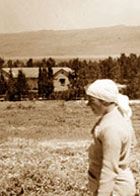Kibbutz

Passover marks the anniversary of humanity's longest-running experiment in freedom. Another celebrated experiment—the kibbutz—kicked off its centennial on the first day of the holiday. In the hundred years since ten men and two women obtained land from the Jewish National Fund for their commune, Degania, kibbutzim have been the scene of sacrifice, achievement, heartbreak, decline, and attempted renewal. All aspects are central to the story of Israel and Zionism.
Kibbutzim never accounted for more than a fraction of Israel's population; their significance lay in the leaders they produced, their central role in the ruling Labor Zionist movement, and their sharp ideological profile. In coupling agrarianism, collectivism, and a wholesale critique of Diaspora life with a commitment to Hebrew, the Land of Israel, and the Jewish people, they proved beyond a doubt that Zionism was, indeed, a revolution.
The founders of the kibbutzim were certainly rebels, but the very ferocity of their rebellion was a measure of their deep connection to all that they opposed. Their best thinkers, like A.D. Gordon and Berl Katznelson, produced some of the most inspiring ideas of Jewish modernity. Yet with time the fervor waned. The founders had been soaked in Jewish culture and pathos; for their children, raised to be farmers and soldiers, Jewish tradition and the struggles of their forebears were distant memories at best.
By the 1980s, the Labor party was no longer the vanguard of Israeli society, and in the meantime the relentless demands of collective life and the inability of central planning to defy the laws of economics had plunged the kibbutzim into crisis. Many privatized themselves, economically and socially; others selectively adopted free-market elements. By the turn of the millennium, out of 280 kibbutzim, only 30 operated according to the classic model. The ability to adapt has been impressive—as is the number of kibbutz children who still volunteer for combat—but the movement's societal presence is a shadow of its former self.
The privatizations that have saved kibbutzim—and other Israeli institutions—from financial ruin bring their own costs. Kibbutz collectivism expressed not only a particular vision of social equality but also the solidarity necessary to maintain Zionism in any form. Today, a range of ventures, from urban kibbutzim to eco-villages to pluralistic study institutes, draw on the energies and teachings of the movement. Even if, like all utopias, the classic kibbutzim could not maintain the burden of their dreams, in their successes as in their failures they continue to prod the Israeli consciousness.
Comments are closed for this article.




